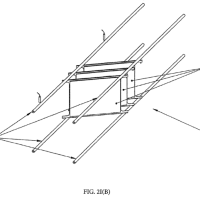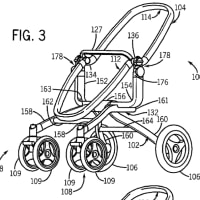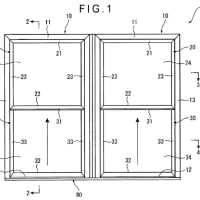US2020054989(JP)
[0037] Specifically, as illustrated in the diagram, the thermal power plant 1 includes
【0031】
具体的には、同図に示すように、火力発電所1は、
a power generation unit 10 including a flue-gas treatment system including a boiler 100, a steam turbine 200, an electric generator 300, and a carbon dioxide recovery system 400,
ボイラ100、蒸気タービン200、発電機300、及び、二酸化炭素回収システム400を含む排煙処理系統を有する発電部10と、
and a control apparatus 20 that controls the devices included in the power generation unit 10.
発電部10に含まれる機器を制御する制御装置20とを備えている。
In the flue-gas treatment system, a denitration device 110 and an air preheater 120 are provided between the boiler 100 and the carbon dioxide recovery system 400,
ここで、当該排煙処理系統には、ボイラ100と二酸化炭素回収システム400との間に脱硝装置110及び空気予熱器120が設けられ、
and a smokestack 130 is provided on an exit side of the carbon dioxide recovery system 400.
二酸化炭素回収システム400の出口側に煙突130が設けられている。
WO2017046155
[0002] Combustion of fuel sources such as coal produces a waste gas, referred to as "flue gas" that is to be emitted into an environment, such as the atmosphere.
【0002】
石炭などの燃料源の燃焼は、大気などの環境中に排出される、「排煙」と呼ばれる排ガスを生成する。
The fuel sources typically contain sulfur and sulfur compounds which are converted in the combustion process to gaseous species, including sulfur oxides, which then exist as such in the resulting flue gas.
燃料源は、典型的に、燃焼プロセス中に硫黄酸化物を含むガス種に変化し、よって結果として得られた排煙中に存在する、硫黄および硫黄化合物を含む。
The fuel sources typically also contain elemental mercury or mercury compounds which are converted in the combustion process to, and exist in the flue gas as, gaseous elemental mercury or gaseous ionic mercury species.
燃料源は、典型的に、燃焼プロセス中にガス状の元素状態の水銀またはガス状のイオン性水銀種に変化し、排煙中に存在する、元素状態の水銀または水銀化合物も含む。
[0003] As such, flue gas contains particles, acid gases, noxious substances and other impurities considered to be environmental contaminants.
【0003】
よって、排煙は、環境汚染物質とみなされる、粒子、酸性ガス、有害物質および他の不純物を含む。
Prior to emission into the atmosphere via a smoke stack, hereinafter a "stack", the flue gas undergoes a cleansing or treatment process.
煙突(以下では「排気筒」という。)を経て大気中に排出される前に、排煙は浄化または処理プロセスを施される。
In coal combustion, one aspect of this treatment process is normally desulfurization, such as a wet scrubbing operation commonly known as wet flue gas desulfurization (WFGD).
石炭の燃焼では、この処理プロセスの一態様は、通常、湿式排煙脱硫(wet flue gas desulfurization;WFGD)としてよく知られている湿式除塵運転などの脱硫である。
[0006] A number of generally known methods of mercury removal are effective to produce mercury salts, which can then be dissolved and removed by an aqueous alkaline slurry used in a wet scrubbing operation.
【0006】
一般に知られている多くの水銀除去方法は、湿式除塵運転に用いられる水性のアルカリ性スラリーにより溶解し除去できる水銀塩を生成するのに有効である。
Some of these methods include the addition of halogen or halogen compounds, such as bromine, to the coal or to the flue gas upstream of the wet scrubbing operation
これらの方法のいくつかは、ハロゲンまたは臭素などのハロゲン化合物を石炭または湿式除塵運転の上流で排煙に添加して、
to provide oxidation of elemental mercury to ionic mercury and to form mercury salts, which are then dissolved in an aqueous alkaline slurry incident to the sulfur oxide removal processes.
元素状態の水銀をイオン性水銀に酸化させるとともに、硫黄酸化物除去プロセスに付随する水性のアルカリ性スラリー中に溶解される水銀塩を形成することを含む。
However, the removal of mercury in the aqueous alkaline slurry of a wet scrubber, or in a less typical seawater scrubber, has proven to be difficult to control.
しかし、湿式除塵装置またはあまり典型的ではない海水除塵装置において水性のアルカリ性スラリー中の水銀を除去することは、制御が困難であることが判明している。
Further, efficiency is not easily predicted when designing a flue gas cleaning system with respect to mercury removal.
さらに、水銀除去に関する排煙浄化システムを設計するときの効率を予測することは容易ではない。
The desired emission guarantee levels are often as low as 0.3 μg/Nm3 of mercury, which corresponds to a very high mercury removal efficiency for a flue gas treatment system.
所望の排出保証レベルは、排煙処理システムの場合における非常に高い水銀除去効率に相当する、0.3μg/Nm3ほどの低い水銀となることが多い。

























※コメント投稿者のブログIDはブログ作成者のみに通知されます